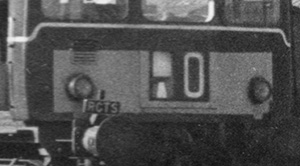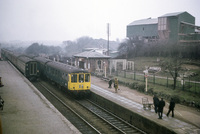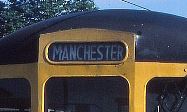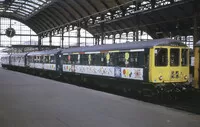Class 104 BRC&W 2, 3 & 4-car DMUs
Liveries
The Green Era

Green with lion over wheel emblem
The first few sets delivered - at least the first four - were in the darker loco green. Power cars carried the lion over the wheel emblem, which always faced the cab. The cream lining was thinner at the top that at the waist, the waist lining had a 3/8 inch black edging. The tyres on the wheels were painted white, the vehicle number was painted on the bogie along with /1 or /2 denoting either no.1 or no.2 bogie. Buffer beams were red, and shedcodes would appear painted on these. Blue squares were on the lower ends of the vehicles. Cab roof domes were white, roofs were a light grey. At least the first set (pictured) had a much lighter roof colour, almost matching the cab dome. The more commonly used works image was of the fourth set. It was unusual to redo works photos that soon - the dislike of the lighter roof colour could be the reason. One other difference between the two images is the first set did not have the route indicator blinds fitted.

Green with coaching crest
Very soon into production a systemwide change was made to use the coaching roundel. The logo change would also mark a change in the shade of green used, they would now be the lighter multiple unit green. Initially there was a left hand and a right hand version of the crest, when applied they would always had the lion facing the cab end of the vehicle. The right facing ones were done away with around 1960 so all subsequent ones faced left, no matter which side they were fixed. Sets as late as 50470 (January 1958) were delivered without whiskers. The image shows M50436 arriving into Manchester London Road in 1958. Stuart Mackay Collection.

Green with whiskers
Whiskers appeared on later vehicles when new and were often added to those that were delivered without. The latter resulted in many variations of the whisker style. The image shows E50586, which almost certainly had whiskers when delivered, at Stockton in 1960. Note the end steps still fitted to the adjacent trailer brake second. Steve Davies Collection.
In spring 1958 the sets stationed at Stoke-on-Trent were appearing with the shed code 5D on the front & rear buffer beams.

Green with yellow panel
Around two to three years after delivery, vehicles underwent their first works overhaul receiving the darker BR loco green livery, and from 1962 half yellow warning panels started to replace the whiskers. The image shows such a set at Aldridge on March 7, 1964. Michael Mensing.

The top of the yellow panel was normally in line with the top of the grille / destination box cover, but a handful of Eastern Region vehicles had a smaller yellow panel that cut through the grille, seen in the close of up of E50589.
In the yellow panel era the roof and cab dome colours varied. Sometimes the roof dome was kept white, but it was more usual to be painted in the roof color. The roof colour could be a lighter or darker grey, and there are instances of ex-works vehicle with the cab dome being a darker grey than the roof.

Green with full yellow end
At least one vehicle - DMS M50501 - received a full yellow end while still in green. It also had a yellow stripe applied for first class, rarely seen on a green vehicle outside Scotland.
It is seen as part of a hybrid set at Derby Midland circa 1969. The other two vehicles are in blue, a BRC&W centre car and a Cravens DMBS. Graham Clark.
The Rail Blue Era

Plain Blue with small yellow panel
Blue made its appearance in late 1966, first applied by an airless spray, which gave it an egg shell type finish, with red bufferbeams, umber brown underframe and bogies, and half yellow panels. This was quite a rare livery for this class, applied to very few vehicles. Other distinct features in this variation was the BR logo was on the cab door, the numbers were smaller at just 3" high (they had been 4" in green).

The first image shows a three-car set (two vehicles in green, the closest in blue) in Buxton (Midland) station on January 14, 1967 with the 10.30am for Millers Dale. The size of the yellow panel was similar to that applied to green livery. Stuart Mackay Collection.
Vehicles that went through Doncaster Works (the (North) Eastern vehicles) received a larger yellow panel, covering the whole of the lower half of the cab. This style is seen in the second image on a hybrid set in the Up bay at Selby station. Pete LG99.

Plain Blue with yellow cab doors
Another very short lived variation. Vehicles known to have carried this include 50447 and 50496.

Plain Blue with yellow end
This soon became the standard in the corporate blue era, gloss rail blue with black underframe and bogies and full yellow ends. For the majority of vehicles this was to be their last livery.
This image demonstrates standard blue livery applied to a set at Duffield on the 16th February 1980. Graham Turner.

White Stripes
Thirteen Newton Heath three-car sets dedicated to Manchester to Blackpool services had bogie modifications to improve their ride qualities in the late 1960s/early 1970s. In 1970 these had a white stripe added just below the windows running the full length of the vehicle side (but not wrapping round to the vehicle ends). M53524 was the last of the class to carry this stripe, which it still had in February 1985.
The image shows 50476, 59184 and 50528 at Preston on 25/1/80 with the white stripe. Jerry Glover.

Variations
White cab roofs were painted onto Buxton allocated vehicles (the odd non-Buxton vehicles were also treated). It has been quoted that this was an attempt to keep the cab interiors cool during the summer - the white paint reflecting the heat - although there's no evidence to support this.
The white roofs appeared throughout the green livery period and during the mid-1970s. They again made an appearance during the early 1980s with some vehicles also gaining black windscreen surrounds. The image shows such a set at Llandudno on 14/7/85. Kenneth Leiper.

At least one vehicle, 53507, had the yellow cab front extended to around the destination blind. This happened circa 1986 and remained until the vehicle was withdrawn.

Blue Grey
None of the class were refurbished, so they skipped the white with blue stripe livery, and for most vehicles plain blue livery was their last. A few did receive blue / grey livery, and the first to do so was 59153 in May 1981 during its time at Etches Park to match the Cross-Country sets it was working in. Not long after it was transferred to Newton Heath.
The first full B/G set was BX487 formed 50434 - 59132 - 50424, outshopped from Swindon in September 1981. Other LMR blue / grey vehicles were 59149 (observed March 1983 with blue power cars 50475/527), 59160, 59168, 59206 and 59207. Later transfers to the Scottish and Western Regions also became candidates for this livery, and other vehicles known to carry it include 53461, 53473, 53477, 53505, 53525, 53534, 53540, 59183 and 59215.
The image shows set BX487 waiting at Manchester Piccadilly with a train for Buxton on 20/11/1983. The original B/G centre car from this set 59132 was withdrawn in March 1983 and replaced by 59207 which had a deeper grey band. 53A Models of Hull Collection.

Blue Grey with black stripe on cab
In March 1982 50446 and 50521 underwent an experimental single-engine conversion at Doncaster and emerged in blue and grey with a black horizontal bar on the cab front, to identify it as being part of an experiment. At first they retained the same numbers, but by a year later were renumbered as 78851 and 78601. They also carried the experiment number EXPDM352 on the cab front. The pair are seen in Manchester Piccadilly, date unknown. Stuart Pearce.
Other liveries

Mexican Bean
A one-off livery was applied to M53424 + M53434 when it was transferred from Buxton to Eastfield for use on an Oban - Crianlarich summer shuttle which operated for three years. Both vehicles were painted from blue & grey into a white and crimson livery which gained it the nickname of the 'Mexican Bean'. It was also emblazened with tourist board markings, black window surrounds and whiskers. It carried a Scotty Dog - the Eastfield depot logo - the first year (1985) this was a small size, in 1986 and 1987 it was much larger. The images shows the set at Oban on 11/08/1986. Graeme Phillips Collection.

Network South East
Network South East livery was applied to ten vehicles in 1989, these being 53429/437/455/470/477/479/539/540 and 59163/206.
The first pair treated were 53455 + 53539 (L702) in February.
The image shows 53437 at Gospel Oak as part of set twin DMBS set L701. Undated. John Stewart.
And finally — flowers!

Not strictly a livery, but a four-car set (and a Class 105 twin) was specially decorated in the summer of 1970. The image shows it in Hull Paragon station on June 1970. Allan Dawson.
This was to publicise the Scarborough branch. On a day in June 1970 they operated two "Classroom Specials" carrying 300 children, one from Hull and one from Scarborough, running via Bridlington and passing at Driffield.
Simon Lee adds "BR invited schools along the line from Scarborough to Hull to nominate two pupils for two special trains. I was picked from my school, and went from Hull to Scarborough and back on the two-car Cravens. Both sets were decorated with stickers with flower comic symbols etc, the theme coming from the Ken Dodd show which was on at Scarborough for the season. Ken Dodd joined both trains swopping over at Driffield. Both units ran with the stickers on for a few weeks after the event. As an aside, there was a story/art competition for the kids who went on the trips, I was one of 5 boys who won the story prize, which was a Triang DMU (Blue Met Cam) presented by Ken Dodd at the Futurist Theater Scarborough later in 1970."
On the day of the school run Driffield was renamed 'Diddy Town' and Ken Dodd was wearing a guard's uniform. An image of part of the train, taken on July 15 1970, appeared in the December 1970 issue of Railway Magazine.
The set can also be seen in this image at Woodlesford and glimpsed in this image at Bridlington.
Summary
Ordering Details
Description
Interiors
Modifications
Single Engine Conversion
2-car diagrams & Works Pics
3-car diagrams & Works Pics
4-car diagrams & Works Pics
Numbering & Drivers Instructions
Liveries
Operations - Early Days
Operations - Later Days
Operations - Scotland
Accidents
Decline
Non-Passenger Use
Images
Details about preserved Class 104s can be found here.
Many thanks to Kevin Dowd for his assistance in the preparation of these pages, and to Eddie Knorn for further data.


